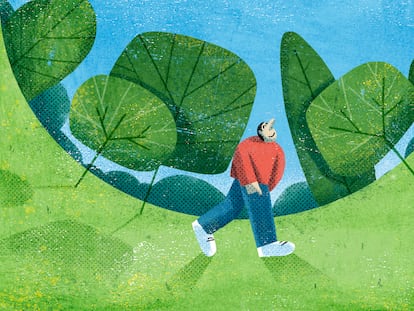‘Light walks’: why exposing yourself to natural daylight is vital for health
Experts recommend increasing the number of hours spent outdoors in the morning, especially for the elderly

In the pages of This book will make you live longer (or at least better), neuroscience and human behavior expert Tamara Pazos writes that one of the best pieces of health advice is to take morning walks with exposure to daylight. “I talk about ‘light walks, health walks.’ Physical activity outdoors, where we receive natural light through our eyes and skin, has many benefits for our health on the cellular level, at the organ level and even at the level of general well-being and mood,” Pazos explained to EL PAÍS.
The journal Nature Mental Health recently published a study, led by researchers at Monash University in Australia, on light exposure and its impact on mental health. It is the largest such study conducted to date, with data from almost 87,000 people from the UK Biobank. The work concludes that people who are exposed to large amounts of light during the day see their risk of depression reduced by 20%. A similar drop in risk was also seen in other mental disorders such as psychosis, bipolar disorder, generalized anxiety disorder and post-traumatic stress disorder. Study participants who were exposed to large amounts of light at night saw their risk of developing certain mental disorders increase by 30%.
“Today, humans defy our biology and spend about 90% of the day indoors under electric lighting that is too dim during the day and too bright at night, compared to natural light and dark cycles,” said Sean Cain, the lead author of the study and associate professor at the School of Psychological Sciences at Monash University. He added: “This confuses our bodies and makes us feel bad. Once people understand that their light exposure patterns have a powerful impact on their mental health, they can take some simple steps to optimize their well-being: the simple practice of avoiding light at night and seeking brighter light during day could be an effective, non-pharmacological means of reducing serious mental health problems.”
Tamara Pazos highlights an extra benefit of walks early in the day: they help set our biological rhythms. “When the brain receives through the eyes the information that it is dawn, the signal works as a timestamp that tells our organs that this is the first moment of the day and coordinates hormonal production for the rest of the day, including the night. If throughout the week we are exposed to that first light of day, our internal clock is on time, helping us to be active during the day and to secrete the appropriate substances to rest at night,” she points out.
This reflection is seconded by José Ángel Rubiño, nurse, neuropsychologist and member of the Neuropsychology and Cognition research group of the Balearic Health Research Institute, who believes that neither the general population nor medical professionals are aware of the importance of light and its effectiveness in the adjustment and synchronization of biological rhythms. “Light is a synchronizer and is considered the most important of all synchronizers, even more than keeping a regular meal schedule, the type of food eaten, physical exercise, social relationships and routine itself,” he argues.
As the expert explains, exposure to natural light early in the day effectively inhibits melatonin secretion and, at the same time, produces a greater availability of serotonin, a neurotransmitter “that is responsible for the stability and regulation of mood and emotions, among other functions such as the immune response, appetite, libido and control of body temperature.” Rubiño highlights above all the relationship between lack of exposure to natural light and mood: “There is a bidirectional relationship between sleep problems and alterations in circadian rhythms with states of depression and anxiety. Therefore, we must integrate resources such as natural or artificial light into the therapeutic approach to depression that help enhance pharmacological and non-pharmacological treatments.”
José Ángel Rubiño recommends exposure to natural light for 30 to 60 minutes between 9:00 and 11:00 a.m., which is when you can get the best benefits from these walks.
This recommendation applies to all age groups. In fact, the Spanish Federation of Sleep Medicine Societies (FESMES) recently highlighted the importance of boys and girls walking to school: “With more physical activity first thing in the morning, with exposure to natural light, [people experience] more wakefulness neurotransmitters and more melatonin and sleep neurotransmitters at night. In addition, school performance increases and episodes of behavioral problems in the classroom decrease.”
Vulnerable groups
The recommendation is especially important in the case of elderly people, who, according to Cristina Nicolau Llobera, member of the Chronobiology working group of the Spanish Sleep Society (SES), have two handicaps that make them a vulnerable group. On the one hand, they expose themselves less to natural light by going outside less; on the other hand, they present physiological ocular alterations typical of old age, which causes them to require a higher dose of natural light than a younger person to obtain the same benefits: “Sensitivity to light decreases physiologically with age, so light exposure must be greater than in young people to ensure that the aforementioned ocular physiological alterations do not interfere with the transmission of light to the Suprachiasmatic Nucleus, the main clock that regulates melatonin synthesis and circadian rhythms.”
This lack of exposure to sunlight, the expert points out, translates into more sleep disturbances, such as insomnia, excessive daytime sleepiness and fragmentation of nighttime sleep. In addition, he adds, it can also have an impact on the appearance of mental health problems (anxiety, depression, etc.) and age-related cognitive decline. Light dictates the sleep-wake cycle and has a significant influence on alertness and different cognitive processes, including attention, executive functions and memory.
For Nicolau Llobera, it is “essential” for older people to go out and expose themselves to natural light as much as possible. “It is advisable to take at least one walk daily, which ensures good exposure to light, and, if possible, encourage outdoor activities, which promote socialization and exercise, two other important synchronizers of circadian rhythms,” points out the member of the Neurophysiology of Sleep and Biological Rhythms research group at the University of the Balearic Islands, who adds that at home it is advisable to keep windows with curtains, blinds or shutters open during the day and complement it with good, high-intensity electric lighting. “If it can be allowed, it is advisable to implement dynamic lighting systems in homes and residences, with white light during the day and warm light as nighttime hours approach, to ensure not only good daytime exposure, but also the necessary light-dark contrast,” concludes the expert.
Sign up for our weekly newsletter to get more English-language news coverage from EL PAÍS USA Edition
Tu suscripción se está usando en otro dispositivo
¿Quieres añadir otro usuario a tu suscripción?
Si continúas leyendo en este dispositivo, no se podrá leer en el otro.
FlechaTu suscripción se está usando en otro dispositivo y solo puedes acceder a EL PAÍS desde un dispositivo a la vez.
Si quieres compartir tu cuenta, cambia tu suscripción a la modalidad Premium, así podrás añadir otro usuario. Cada uno accederá con su propia cuenta de email, lo que os permitirá personalizar vuestra experiencia en EL PAÍS.
¿Tienes una suscripción de empresa? Accede aquí para contratar más cuentas.
En el caso de no saber quién está usando tu cuenta, te recomendamos cambiar tu contraseña aquí.
Si decides continuar compartiendo tu cuenta, este mensaje se mostrará en tu dispositivo y en el de la otra persona que está usando tu cuenta de forma indefinida, afectando a tu experiencia de lectura. Puedes consultar aquí los términos y condiciones de la suscripción digital.
More information
Últimas noticias
Most viewed
- Reinhard Genzel, Nobel laureate in physics: ‘One-minute videos will never give you the truth’
- Oona Chaplin: ‘I told James Cameron that I was living in a treehouse and starting a permaculture project with a friend’
- Pablo Escobar’s hippos: A serious environmental problem, 40 years on
- Why we lost the habit of sleeping in two segments and how that changed our sense of time
- Chevy Chase, the beloved comedian who was a monster off camera: ‘Not everyone hated him, just the people who’ve worked with him’










































